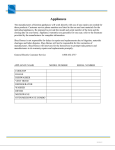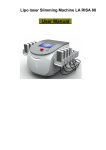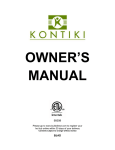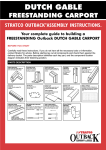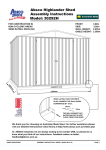Download New Home Owners Manual
Transcript
New Home Owners Manual Please keep this booklet somewhere handy. It will serve as a quick reference whenever you’re making some improvements or just carrying out general home maintenance. Name: New Home Address: Contract No: Key Security No: Practical Completion Date: House Type: notes 1 Residential notes New Home Owners Manual contents Introduction......................................................................................... 4 Termite Treatment............................................................................... 5 Bricks.................................................................................................. 5 Doors.................................................................................................. 6 Ceramic Tiling...................................................................................... 6 Cabinet Work...................................................................................... 7 Appliances........................................................................................... 8 Electrical.............................................................................................. 8 Mould.................................................................................................. 9 Plastering............................................................................................ 11 Plumbing............................................................................................. 12 Sewers................................................................................................ 12 Bathrooms.......................................................................................... 13 Windows............................................................................................. 13 Roof Structures................................................................................... 13 Gutters, Valleys & Downpipes............................................................. 14 Smoke Alarms..................................................................................... 15 Painting............................................................................................... 16 Driveways............................................................................................ 16 House Numbering............................................................................... 17 Clay Sites............................................................................................ 18 Securing Your Home........................................................................... 19 - 22 Starting Your Garden........................................................................... 23 - 24 Lighting............................................................................................... 25 Handy Hints - How to Deal with Stains................................................ 26 - 27 Maintaining Your Tiled Areas............................................................... 28 - 29 Painting Your New Home.................................................................... 30 - 33 Moving Into Your New Home.............................................................. 34 - 36 Thank you for Taking the Time To Read your Home Manual............... 37 2 3 Residential New Home Owners Manual Introduction Termite Treatment We thank you for choosing BGC Residential to construct your new home and trust you will enjoy many years of happiness and prosperity. Your home has been treated for termites in accordance with the relevant standards. Your builder gives a 12 month warranty, however it is your responsibility to maintain this treatment and have regular inspections. The original contractor’s details are placed in your meter box. If there is evidence of termites invading your home please advise your builder immediately. To assist you in maintaining your home we have compiled an assortment of useful information which we recommend you read and keep handy at all times. In order to simplify and provide an efficient post construction service we ask you to log minor items which arise during the 180 day post construction defects liability period on the enclosed form and forward it by the due date to After Sales Service Department, PO Box 115. Mt.Hawthorn WA 6018, phone: 6461 5600 email: [email protected] If there are any problems which are considered to be an urgent nature prior to the post construction inspection we ask you to contact us immediately; South of River Phone Fax (08) 9261 1866 (08) 9334 4966 North of River Phone Fax (08) 9248 7455 (08) 9248 6312 Mount St. Head Office Phone (08) 9261 1866 Fax (08) 9261 1889 Address PO Box 7196 Cloisters Square. WA 6850 Australia. Please be aware that many different types of materials have been used in the construction of your home and will be subject to:- 4 n Natural shrinkage and settlement of roof timber. n Differential movement of concrete and brickwork. n Expansion and contraction of steel members. n Shrinkage and swelling of timber joinery. n Differential movement of clay foundations. n Ceiling cornice movement. n Thermal movement caused by changing weather conditions. These are not defects and there is no need for concern as your home is not failing structurally. Construction built close to the boundary (such as garage parapet walls) may be affected by adjoining neighbours and require more regular visual inspections. Termites are a totally different insect to an ant. If ants are invading your home, don’t be alarmed. Remember you have probably invaded their homes and territory when your house was built! An ant in the kitchen doesn’t mean that the builder has left holes deliberately. They are simply looking for moisture or food. It’s up to you to decide whether or not you wish to treat your home with chemicals or natural remedies. Bricks The external bricks of your home act as a weather-proof coating and only in rare designs will they be used to support the weight of the roof (eg. single leaf garage or store walls where the rafters are pitched to the external brickwork). Single leaf walls are not intended to be waterproofed, so you should be conscious of what is stored against them. It is important not to design your gardens too close to the house, as constant damp ground and shrubs touching brickwork may cause moisture condensation through the cavity and damage carpets or the internal plaster. Usually, along the bottom course of the external brickwork, the builder has left what is called weep holes. They are to let moisture drain out of the cavities, so don’t block these holes and make sure garden sprinklers always face away from the brickwork. Vanadium staining to the brickwork usually occurs on light coloured clay face bricks in the form of a yellow or green discolouration and is neither permanent nor harmful and is not a fault with the bricks or of the workmanship. Such stains on exposed areas generally wash off in time, however, their removal can be hastened by chemical treatments. Please contact your brick manufacturer for further information. 5 Residential Doors Cabinet Work Varnished external doors need re-coating every year as sunlight will rapidly breakdown the varnish coat, exposing unprotected areas which may then start to delaminate the door surface. With proper care the surfaces of the cabinets and tops will keep their good looks for many years. There are limits to the warranty for cabinets and tops, so the following guidelines need to be adhered to: External doors may need adjustment because of shrinkage which misaligns the barrel bolts or latch with the striker plate. Bending the striker plate leg inwards or outwards usually is enough to align the door lock. WATER Adjustment of the hinges may be necessary in extreme cases. Door handles need to be tightened and adjusted regularly due to continual use. Doors are often affected by movement due to moisture. It is of vital importance that the home is well ventilated upon occupancy particularly when it has been constructed during the winter months, allowing the doors to dry out and become stable. Ceramic Tiling Future Tiling If you intend to lay tiles or slate instead of carpet, make sure a flexible adhesive is used to compensate for any minor slab movements or shrinkage that can arise with new homes. These adhesives should conform to the relevant standards and be compatible to the all adjacent materials. Some products such as butt joined porcelain may require additional levelling due to the allowed tolerances in the slab. General It is advised you retain all spare tiles and grout left by the builder for possible repairs during the post construction warranty period. You should note that if you have provided your own tiles the provision of spare tiles and grout required for future repairs remains your responsibility, so please ensure that an adequate number is retained. Moisture penetration can occur through the grouted joints between tiles. This grout can be disturbed from settlement of the slab, harsh cleaning agents or scrubbing brushes. The builder is not responsible for problems resulting from the misuse of tiles (eg. chips from falling objects) or discolouration associated with the use of harsh cleaning agents or detergents. Tile cleansers are available from tile suppliers which will assist. If grout or flexible jointing becomes dislodged in showers, prompt maintenance should be carried out as soon as possible to avoid moisture damage to adjoining rooms. One area that may be the most likely place for this to occur is the last row of tiles on the bottom of the wall where it meets the floor. Visible voids may often be seen in this area. 6 New Home Owners Manual There is no warranty for cabinets and tops that have been damaged by or are showing swelling caused by water. Materials used are high moisture resistant, NOT waterproof. Water left on surfaces will cause swelling. 4 Keep your cabinets and laminated tops dry at all times. Wipe any split water immediately and dry the surface, in particular take care near laminate joins, sink, basins, bath or shower. 8 DO NOT let the water sit on the bench tops around the sinks or basins, against the grout line or between the vanity cabinet and bath or shower hob. heat 4 Fit window treatments or a patio to keep bench tops from direct sunlight. Use heat protecting mats under pans, dishes and appliances. When using the hotplate always have the range hood fan on and fully extended. 8 Direct sunlight can cause bench top joins to open allowing the combination of laminate movement and water penetration resulting in unrepairable damage. DO NOT place hot pans, kettles or appliances directly onto laminate surfaces. DO NOT leave the gas burners running without a pan on the burner. DO NOT allow vinyl form products any exposure to surface temperatures exceeding 75°c. Cleaning 4 8 Use warm soapy water with a damp sponge to clean cabinets and laminated to surfaces. Chamois or dry with a clean cloth immediately. DO NOT use abrasive, alkaline or acid cleaners such as CLR, Jiff or bleach. These products can quickly etch into the surface causing permanent damage. WARRANTY LIMITATION Warranty will become void when (but not limited to) damage caused by: • Swelling or damage caused by water • Laminate movement caused by the surface temperature exceeding 100°c. • Door failure caused by surface temperature exceeding 75°c. • Improper care and sufficient householder maintenance. 7 Residential Appliances General Appliances supplied and installed by the builder such as stoves, wall or under bench ovens, hot plates and hot water systems are covered by the manufacturer’s warranty. If any faults do occur you should direct your calls to the manufacturer and arrange a time for a service person to call. Please note that the warranty period on these items is for the extent of the manufacturer’s warranty and may differ with some appliances. Warranty cards and service information is removed from packaging during installation and placed in your kitchen drawers. Hot Water Unit Upon handover, please make sure that the gas booster next to your hot water storage tank is plugged into the power point and switched on. The gas booster unit needs to be connected and switched on for the hot water system to work. New Home Owners Manual n If an appliance doesn’t work, it is possible that the appliance itself is faulty, rather than the power point, which can trip off the main power at the circuit breaker switch. Check this by using a different appliance at the same power point. If this works without tripping the switch then the original appliance is faulty. n If at first you can not identify what is causing the problem, it will be necessary for you to unplug all appliances and go through one by one plugging them back in. Irons, vacuum cleaners, toasters or kettles are the main culprits. n Power surges will also trip off the main power. If this is occurring regularly it may be due to the fact that you are in close proximity to a Synergy sub station in which case you should direct your enquiries to Synergy. If an exhaust fan doesn’t seem to be working, it may be that the cord is either not plugged in or the cord in the roof may be hanging down obstructing the blade. If the fan makes a humming noise when turned on but the fan appears not to be turning, please call our office for further advice. As for other appliances, exhaust fans have a limited warranty time and are not an ongoing responsibility of the builder. If you have a gas storage unit, make sure that the hot water system igniter is in position. If missing, please contact our office to organise a replacement, this item is a regular target for theft. Mould Initial igniting of hot water systems can take time due to the length of gas run to the hot water system. It is suggested that you prime the line by holding the button for around three minutes then leave the unit to disperse any excess gas. Then, return to light the unit under normal ignition procedures (as noted on the door panel of unit). Do you have mould in the closet or on the ceiling? Unfortunately, it can be difficult to prevent it. A significant amount of moisture will be retained in your home long after completion, particularly in homes built during the winter months. Electrical Before Synergy connects power to a house, all circuits and wiring are checked. After approval, power is connected and this approval usually indicates the electrical aspect of the house is faultless. It is not uncommon for certain power points to remain isolated for safety reasons, eg. a bathroom power point if the shower screen was not installed until after the electrical final. Your home’s electrical circuits have a safety switch installed called a Residual Current Device (RCD). This is a circuit breaker similar to fuses in older homes that would need rewiring if the electrical load was too great and the fuse wire burnt out. If you experience problems after taking possession of your home, check the following before contacting your builder. Moisture presence in the walls, concrete slab, roof tiles, ceilings etc., will in time lessen. However, it is vitally important that the home is ventilated. This will allow the appropriate and gradual drying out of the home and reduce the potential for mould growth. Keep your robe doors ajar to allow ventilation to the robe as moisture is often trapped in this area. In addition to the atmosphere being laden with moisture, our daily activities add to the problem through breathing, laundering, bathing and cooking. Remember, ventilation helps to prevent condensation which in turn causes mould. Plaster vents in the corners of the ceiling are not used these days, for the good reason that they soon block with dust, fail to ventilate and give a false sense of performance and affect the energy rating of a home. An adequate level of ventilation is best achieved through the windows. Ceiling insulation will restrict the amount of moisture which condenses on the ceiling and lessen the potential of mould growth in this area. The mould grows where it is most moist, clearly showing the value of insulation. High temperatures do inhibit the growth of spores but to raise the temperature by sealing your home will not solve the problem. Heating and ventilation are both needed. 8 9 Residential Mould (cont.) Plastering The trend to install gas heaters without flues is attractive as a cost-saver but it is conducive to mould growth because the burnt gas leaves considerable water vapour. High and low level vents are provided to help this and must be kept clear at all times. Traffic areas will soon become evident within your home by way of chips and scratches on the corners (or bullnose) of your walls. Care must be taken around tight corners and openings. Remember plaster is not designed to withstand knocks or heavy bumps with furniture and these are not considered defects. Spak Filler will come in handy when maintaining your walls. Most bathrooms have an extractor fan which is essential in the view of the small windows in these areas. As the fan does create a cold draught we tend to leave it off when we need it the most in the moist winter months. While moisture may be evident in a bathroom, the problem is not solely in that room. The water vapour we generate is invisible so that does not help us identify the problem. The rooms which suffer most are on the South side of the house as they do not get the warm winter sun from the North. Laundries with unvented dryers are also big generators of water vapour. Ducting the exhaust through the wall may well cost less than the damage to walls, ceilings and clothes caused by mould. While mould can be easily removed with household bleach or proprietary mould removers, it will soon return unless prevention is undertaken. A low sheen acrylic paint will resist moisture penetration and it is more easily washed than the flat type. Here is a check list for an assessment of your home: n Do the windows allow partial ventilation at all times? n Is ceiling insulation installed? n Does the bathroom have an extractor fan and is it wired to the light switch? n Is there a range hood over the kitchen cook top? n If a dryer is used in the laundry, does it vent to the atmosphere? n If a gas heater is used is it vented to the atmosphere? n Are all surfaces in wet areas protected with tiles or gloss enamel? Recognising these factors will stop moisture build up in the home and with the result that mould growth will not be sustained. Ceilings and walls will stay in their pristine state and windows will stop running with condensation each night. 10 New Home Owners Manual Cracks in plaster may occur around the ceiling cornice because of settlement of the roof or shrinkage of roof timbers and doesn’t pose a serious structural problem. Most cornice cracks are repaired at the maintenance time but some ongoing settlement becomes the responsibility of the home owner and may bring about the need for minor maintenance to be carried out by the owners. Make sure the loose plaster is scraped out before filling along the cracked cornice. Cracks in the walls over windows and door frames or around the bottoms also rarely pose a structural threat and in most cases are easily filled by scraping a deep V shape groove and filling. Some cracks may re-open again because of further settlement or shrinkage. This doesn’t necessarily mean that the previous repair method wasn’t done right – it’s not uncommon for certain cracks to be maintained 3-4 times within two years or more. To help you understand what is considered acceptable cracking and distortion we’ve included the following information taken from “Structerrre Consulting Chartered Engineers” Classifications and Cracking Charts. DESCRIPTION OF TYPICAL CRACKING APPROX MAXIMUM CRACK WIDTH 1. Straight cracks along the junction of the ceiling cornices & wall Up to 2.0mm 2. Jagged cracks along the junction of the ceiling cornices & wall resulting in some of the white set remaining attached to the cornice Up to <2.0mm 3.Straight line plasterboard Up to <0.5mm separation between sheets of 4. Jagged separation within a Plasterboard sheet Up to <1.0mm 5. Lateral movement of the cornice away from the wall Up to <1.0mm 6. Popping screws in the Plasterboard sheets. This dimension is measured from the surface of the ceilings to the head of the popped screw Up to <0.2mm 11 Residential Plumbing Leaks under your kitchen sink, laundry trough and vanity basin may be due to shrinkage of the rubber seal in your waste pipe. Extra hand tightening may eliminate an unnecessary service call and damage to shelving. It is important to check inside of cupboards periodically. Replacing tap washers may be common within the first 12 months due to sand particles wearing on the washer. Keeping spares is recommended especially if your house is one of the first in the subdivision. If you have a dripping tap, try turning the tap on full for a few seconds to dislodge any large particles of sand. This may save you changing the washer unnecessarily. Water hammer is not uncommon in some areas due to higher than normal water pressure to service future homes in the area. The more built up your area becomes the less pressure from the mains and also less noise from water hammer. Try turning taps off more gently to minimise the noise. Water Hammer Arresters may be another option and are available at your local hardware store. Hot water units may lose up to four litres of water per day through the pressure relief pipe. Regular release of the valve lever will help keep your tank clear of damaging particles. Sewers The sewer is generally positioned around the perimeter of your house running directly to the Water Authorities connection point. Be conscious of this when digging in the future. The drains overflow is called the relief gulley or disconnector trap (D.T) and is usually found close to the brickwork at the end of the line. It has a black grate over the top and is like a safety valve, so if the sewer system backs up for any reason water will be released from the D.T rather than through your toilet or floor wastes inside the house. It is important to keep the soil 50mm below the top and don’t plant your garden too close. Children also like to play and fill up the drain hole with stones, sticks and toys, so be aware the majority of blocked sewer drains start at the D.T. The exits to floor wastes are the pipes which you will see outside of the laundry and bathrooms with an end flap. These should be kept free of debris at all times. 12 New Home Owners Manual Bathrooms One area that may need regular monitoring in the bathroom is the joint between the edge of the bath and the tiles. These days, this is done with a flexible sealant rather than grout so maintenance should be minimal. If you do need to maintain the joints, make sure you get a silicon based product with mould resistant properties and be prepared to re-seal these areas every few years. Do not use abrasive materials on acrylic baths, basins, troughs, laminated surfaces or glass. It is worthwhile noting that the direct flow of extremely hot water on the glass of your shower screen may result in the glass cracking. Avoid direct contact of hot water on the shower screen whilst the correct water temperature in being achieved. Windows It is essential to ensure that all sliding door and window tracks are kept clean of sand as the abrasive action will affect the performance of the roller wheels. In such cases replacement of rollers may be required. These are available directly through your window manufacturer Affinity Windows on 9334 4600. If you live within a few kilometres of the coast, it is also recommended that you wash down your window frames with fresh water to remove salt deposits at least twice a year. This will also extend the life of these products. Most leaking window problems can be attributed to condensation forming on the inside of the glass which, as we have already discussed, may create mould on ceilings, walls and curtains. Keep all rooms well ventilated to prevent this. Roof Structures Keep trees from over-hanging gutters as leaves are the most common cause of blocked down pipes and storm water drains. If your house has experienced a few rains and no stains have appeared on the eaves or internal ceilings then usually you have a water tight roof. However, if some time down the track a stain does appear, make sure (before contacting the builder) that it is their responsibility eg. Have you had contractors on your roof installing antennas, air conditioning? If a workman has damaged your roof it is unlikely he will advise you. Was the damage caused by an excessive storm? This may be an insurance claim rather than a defect. As the roof timbers in your house will settle in the first two years, hairline cracks may appear in the mortar bed of your roof tiles. These cracks are not related to faulty workmanship and fall under the home owners maintenance responsibilities. Rain does not penetrate these hairline cracks. 13 Residential Gutters, Valleys and Downpipes Your gutters and downpipes are designed for what is called a 1 in 20 year rain fall for a 5 minute duration. It is not uncommon in a heavy isolated storm for this to be exceeded. Your home has been constructed with slotted gutters and is designed to over flow on the face. New Home Owners Manual • T he COLORBOND® steel and ZINCALUME® steel should be thoroughly rinsed with clean water immediately after cleaning to remove traces of detergent. Never use abrasive or solvent type cleaners (turps, petrol,kerosene, paint thinners) on COLORBOND® steel and ZINCALUME® steel. If cared for in accordance with these instructions, your building components made from COLORBOND® prepainted steel and ZINCALUME® steel will give many years of low maintenance life. When roof drainage soak wells are required it is worthwhile fitting oversized soak well adaptors to downpipe shoes to allow an overflow point when the soak well capacity can not cope with the extremely heavy rain. Soak wells and silt pits must be cleaned of leaves, debris and sand on a regular basis. This information is intended as a guide only. For more information, please see “Technical Bulletin 4 - Maintenance of COLORBOND® prepainted steel roofing” on our Technical Bulletins page. It is highly recommended that you clean out all leaves and debris from your gutters and valleys at least twice a year because these do prevent the flow of the water into the downpipes. If not cleaned the water can back up and come into your home, potentially causing major damage. Smoke Alarms OPERATION & TESTING If you live within a few kilometres of the coast, it is also recommended that you wash down the external surfaces of your valleys, gutters and downpipes with fresh water to remove salt deposits at least twice a year. This will also extend the life of these products. n If the smoke alarm is equipped with a hush/test button. Test the alarm by pushing the HUSH/TEST button for 5 seconds. The alarms should sound simultaneously. Maintain COLORBOND® steel and ZINCALUME® steel n If interconnected alarms are installed, pushing the HUSH/TEST button on one unit should cause all interconnected alarms to sound. n If the alarm does not sound, check the 9V battery and circuit breaker. If alarm still does not sound contact the licenced electrician. Simple maintenance of COLORBOND® steel and ZINCALUME® steel by regular washing with water, will not only enhance its life but maintain its attractiveness for longer periods thus protecting your asset. n The green light indicates that the unit is operating with AC power. If this light is off, the AC power is off and the backup battery will operate the unit for a short period of time depending on battery capacity. Applications where the paint finish is automatically washed by rainwater do not usually require this maintenance, eg. roof cladding. n You will not be safeguarded if the AC power goes off and the unit is not fitted with a fresh battery. Examples of applications requiring maintenance cleaning include wall cladding under eaves, garage doors and the underside of eave gutters. Areas not regularly washed by rainwater should be hosed down at least every six months and more frequently in coastal areas where marine salt spray is prevalent, and in areas where high levels of industrial fallout occur. In cases where the regular maintenance referred to above does not remove all dirt which may have adhered to the surface of the paint, the following procedure should be carried out: • W ash the surface with a mild solution of pure soap or mild non-abrasive kitchen detergent in warm water. • A pplication should be with a sponge, soft cloth or soft bristle nylon brush, and should be gentle to prevent shiny spots. 14 n This test should be done at least once a month to ensure that the alarms are operating correctly. n The red light should flash once approximately every 60 seconds to indicate the unit is functioning and alert. It will flash rapidly when the unit goes into alarm. The flashing light and pulsating loud alarm will continue until the air is cleared. For interconnected alarms, only the unit which senses smoke (or is being tested) will flash rapidly. All other units will sound their alarms but not flash rapidly. n Do not apply excessive force to HUSH/TEST button. Doing so may damage the unit and void the warranty. n Never use an open flame of any type to test your alarm. You may damage the alarm or set fire to your home. Operating the HUSH/TEST button will check for correct functioning. n If the unit chirps once every 30-60 seconds this is on indication that the battery requires replacing. (No battery installed will give the same warning chirps) 15 Residential Smoke Alarms (cont.) MAINTENANCE & CLEANING n If a zinc oxide battery is used, the battery should be renewed at least once a year on the 1st of April each year in line with FESA’s campaign. n If a lithium battery is used, then the battery should be renewed at least every seven years. n The Smoke Alarms are virtually maintenance free. However, vacuuming the unit at least once every six months will remove dust. n Wipe the enclosure clean with a moistened cloth. Do not immerse this unit or use household cleaners. Do not apply paint or spray with any liquid. n All smoke alarms are manufactured and tested to rigorous quality standards and have a minimum life expectancy of 10 years. However, for your safety we recommend replacing your smoke alarm with a new unit after 10 years. This will ensure that you are always protected by a smoke alarm that’s operating within the limits of its life expectancy. Painting New Home Owners Manual House Numbering Local authorities have requested that you ensure that house numbers be prominently displayed on letter boxes or dwellings so that they are clearly legible from the street boundary. The Minister for Local Government has on several occasions advised Local Authorities that emergency services are encountering problems in locating addresses. The Minister has further advised that there is power under Section 314 of the Local Government Act for Local Governments to enforce the numbering of all properties. The Master Builders Association and Housing Industry Association have also been requested to bring this matter to the attention of their members. Advice from Australia Post indicates that 50mm high numerals on a letter box are satisfactory. Where the numerals are located on the building, they should not be less than 75mm in height. The numerals should contrast against the background. Some local authorities are directing that these requirements will be a condition of approval on all Building Licenses issued for new dwellings. All entry doors and any external timber exposed to weather will require yearly maintenance, as will timber window sills exposed to sunlight. This also includes timber garage doors. Please assist us in ensuring these requirements are met, not only for correct mail deliveries but to enable emergency services to operate efficiently. We recommend painting to walls be delayed until the post warranty construction period is complete or alternatively, enough paint from the original batch is retained for touching up any minor cracks that may occur. Should you require any further information, please contact your local authorities Building Department. It is advisable to use good quality sealer as per manufacturer’s instructions prior to painting walls and to use at least low sheen paint in any areas subject to steam, such as bathrooms. Painting concrete floors to minimise dust may create future problems when laying vinyls and ceramic tiles. Professional advice should be sought before applying any coatings to concrete floors. Driveways Your driveway will sustain normal private vehicle traffic, however, heavier vehicles may crack or subside the driveway. Control joints are formed in concrete driveways and paths to isolate cracks. If your driveway has been installed prior to the council crossover it is advisable to place a support prop against the edge of the driveway until it is “locked in” by the crossover. The edge of paved driveways should not be driven on until the crossover is installed. 16 17 Residential Clay Sites Securing Your New Home The following information has been prepared for our clients who have built on clay sites. We recommend this information be adhered to, as to minimise cracking caused by movement from inconsistent moisture content in and around the foundations. It is an unfortunate fact that one of the biggest concerns of the community today is law and order. THE DO’S AND DON’TS FOR HOMES BUILT ON CLAY SITES The fact sheet is a summary of the do’s and don’ts and expectations for performance of houses on clay sites. n Stabilise all cuts and slopes with a retaining wall or by stone pitching. n Expect some movement of the foundation which could result in minor cracking within the home. n Refer CSIRO Sheet 10-91, or AS 2870 for a reference table on degrees of cracking which are considered acceptable or unacceptable. n With your garden maintenance, ensure that the moisture content of the ground around your foundations is kept as uniform as possible throughout the year. n Do not plant native trees and shrubs close to the house (if this does happen ensure that the below is complied with). n Do not plant trees any closer to the house than 1.5 times the mature height of the trees. Home burglaries are a particularly major concern amongst home owners. Helping to secure your new home, so you and your family can live in safety, is ensuring that you have peace of mind by minimising the risk of being a victim of crime. There are a range of measures you can take to ensure that your home and family does not become a target for criminals. THIEVES ARE OPPORTUNISTS The most important point to remember when securing your home is that thieves tend to be opportunists. They often just steal one of two expensive items – jewellery or electronic equipment – and only take a few minutes to rob a home. By making your home visually more difficult for thieves to enter you will ensure that they will be less likely to steal from your home. Deterrence is the best form of home security. NEIGHBOURHOOD WATCH Water garden by an automatic reticulation system, when possible ensure uniform moisture content throughout the year. Your first line of defence against burglars is your neighbours. n Consolidation of the clay bund will result causing cracks between clay bund and sand. This is not any significant consequence. If your neighbours are encouraged to keep a careful watch on each others home, then the risk of being burgled is greatly reduced. n Where possible place paving paths around the home with a fall away from the house. By working together with your neighbours and simply watching each others home then any suspicious behaviour can be quickly reported. n Ensure that all subsoil drains are fully maintained and in working order. n Ensure that all surface drains are fully maintained and in working order. If you are moving into a new neighbourhood, it’s a great idea to join Neighbourhood Watch and encourage others in your street to do the same. n Ensure that all water does not “pond-up” or “flow-up” against the house. n Pipe all roof water away from the house so it won’t pond or cause erosion. n Generally the most amount of movement, causing cracking in the house will occur in the first couple of years as the site adjusts to the new moisture levels and the new equilibrium point about which moisture variations occur, is established. n 18 New Home Owners Manual The best security guards are the people living in your local neighbourhood. Thieves are likely to go elsewhere if they believe that they are being watched and risk being exposed and caught by neighbours. A local community working together to fight crime is perhaps the most effective way of securing your home. 19 Residential Securing Your New Home (cont.) Securing Your New Home (cont.) Landscaping You should also fit a bolt at the top and bottom of the door on the inside, for additional security. How you landscape your new home can play an important role in crime prevention. Thieves need visual protection to commit their crimes. If a home is not visible from the street because of bushes and trees, then thieves can work virtually undisturbed if they enter your home. How you landscape your home can therefore play an important role in home security and the more visible your home is from the street front the more secure it is from thieves. If you have a glass panel in the door then these bolts should be lockable to prevent someone breaking the glass and unlatching the bolts, but always consider emergency fire exits when fitting deadbolts - it’s imperative that easy egress can be achieved if there’s ever a fire. Lighting For additional security, you can install an eye viewer in the door, which allows you to identify the caller before opening the door. Many burglaries occur at night when home owners are asleep. Thieves love to operate in darkness because they cannot be easily detected. Ensuring that the outside of your home is bright at night is another line of defence against thieves. Investing in motion detector-activated or Infra-red external lights is a wise and inexpensive purchase. You should also consider fitting a security chain to your front door so you can partially open the door knowing that no one can burst into your home. Alarms Burglar alarms are your last line of defence because they are activated if a burglar actually enters your home. These lights will automatically switch on if someone comes near your home at night. They also do act as a deterrent if the burglar visually sees that an alarm system has been installed. They are easy to install and come in DIY kits which can be purchased from your local hardware store. Alarm systems have become more reliable in recent years due to advances in technology. They are becoming a very popular home security device. It is also advisable you fit a Synergy approved lockable meter box lid with a viewing window which makes it much more difficult for an intruder to cut off your power and thwart your night time lighting. There are two common types of alarm detection devices: Door or window switches. These are designed to activate if intruders try to force their way into your home for forcing protected windows or doors. It is therefore important that you have effective locks on all windows and doors. Infrared motion sensors which are designed to cover areas where valuables are stored and common areas such as passageways, will activate only if the alarm is set and intruders actually enter the home. Most modem alarm systems allow you to leave door and window switches ‘active’ when you’re at home, while disabling the internal movement sensors to allow free movement inside. Most reputable security companies will provide a free written security assessment of your property, so ask about these available features. As a company, BGC Residential takes home security seriously and that is why we have installed security window locks to your new home. These locks are ultra window locks which are a proven deterrent to thieves. The best kind of system is an alarm which incorporates both features. This will ensure that even if the perimeter alarms are by-passed, the thief will still be detected in the home by the internal passive alarm. Your front door in particular needs special attention. Your security system can be connected to an alarm box with a strobe light mounted on your outside wall, and to the monitoring station of a private Security Company which will respond to the alarm if it is activated. Locks A burglar has to gain entry to your home and the easiest way they can do so is through a window or a door. Thieves will ring the doorbell and if no one answers, they will force an entry. To deter them, you should fit a deadlocking bolt. 20 New Home Owners Manual 21 Residential New Home Owners Manual Securing Your New Home (cont.) Starting Your Garden Many families these days are opting for a back-to-base alarm system because sirens alone are only a partial deterrent, and importantly, because it’s become much more affordable in recent years. There are a number of highly reputable private security companies that will install a complete alarm system for under $1000 dollars upfront, plus a monitoring service fee of approximately $1.00 a day. Your garden is one of the most important features of your new home because it is the first impression people will get of the home. Make sure that anyone you deal with is a member of an accredited organization (ASIAL or WA Security Institute) and always demand to sight a security license issued by WA Police before allowing anyone into your home to quote for an alarm. An excellent garden setting will ensure that the aesthetics of your new home are fully enhanced and that your new home becomes a showpiece. Planning your gardens In many ways planting a garden is no different from building a new home. You need to plan it carefully and once you have an idea of the kind of gardens you would like, then it’s time to get professional advice. Panic Switch A plan is the key to successful new gardens. If you are having an alarm system installed, you can also have a panic button strategically placed in your home. You should begin by taking the plans of your new home and its location on the block to a reputable garden centre or landscape gardener and they will give you a suggested plan of where you should plant your lawns and plants. It can be located near the front door or in a bedroom. If someone gains entry to your home and you are inside, these panic switches allow you to activate the alarm. Even if you are suspicious, you can still activate the alarm through this panic switch. If you install a wireless alarm system, then these Panic Switches can be carried with you anywhere around the home or yard. Plus, if your alarm is monitored back-to-base, then the monitoring centre operators will be able to differentiate a Panic Alarm from a Burglar Alarm and will react accordingly. A reputable landscaper will provide you with a suggested scale plan of your proposed new garden settings which will outline where the lawns, brick paving and plants should be located which best suits your lifestyle and personal tastes. The size and shape of your block and where it is sitting geographically will determine the style of gardens best suited for your home. The front garden The front garden especially needs consideration in terms of the overall style and design of your new home. Your front garden introduces visitors to your home and is very important if you ever decide to sell your home in the future. A shabby front garden that clashes with the style of your new home can undermine the efforts you have put into building your new home, and may even put you in breach of the community design guidelines. Check with your Land Agent or more details. Your lawn The lawn is a critical part of your garden. The type of lawn you can grow will be determined by the location of your home and the kind of soil it has been built on. Sandy soils will require a different kind of grass to clay soils, while the level of sunlight and wind will also be important issues in determining the kind of grass you plant. You can begin to get an idea of the kind of lawn to plant by simply walking around your new neighbourhood to see what lawns people have laid. If you like a particular style of grass then just ask your neighbour for details. 22 23 Residential New Home Owners Manual Starting Your Garden (cont.) Lighting Planting your lawn LIGHT FITTINGS There is a wide range of light fittings available for new home owners, depending on cost and quality. Ensuring that you have a wonderful lawn also requires planning. The key to having a successful lawn and garden is a good reticulation system. Hand watering can be ineffective and tends to encourage shallow roots. Purchasing a good reticulation system, which has a timer, is an excellent investment. Overall, it will save you money both in the short term, by ensuring that your lawn is properly watered, especially during the critical summer months and in the long term by making sure that you do not over water. You may also consider installing a bore to supply your reticulation system requirements. This decision should be made on how much water you believe you will use weighted against the cost of installing a bore, which can be quite expensive. You can save money on light fittings by buying these fittings during special sales or by putting them on lay-by if you cannot pay for them immediately. However, lighting your home is about imagination and you can create impressive lighting effects in your home without spending large amounts of money. To find out more, you can visit your local lighting store or contact an Interior Designer. If you see something you like in one of our display homes, please feel free to call our Head Office on 9261 1866. HANDY Hint A common problem is how to put a reticulation pipe under a path or driveway. This can be done by digging a long hole at right angles to the path (outwards) on one side, and a simple vertical hole on the other side. Both holes should be about half a metre deep. Next, you will need a strong straight pipe that you can run water through. The pipe should be at least half a metre longer than the width of the path or drive. By running water through the pipe it can be pushed through the soil under the path from the side of the long hole. You can then pass the reticulation pipe through the hole to the other side. Be sure to clear loose sand from the pipe so it will not block your sprinklers. Planting and maintaining your lawn The best time to plant new lawn is from the middle of September to February. If you plant roll on lawn then you should lightly top-dress after you have laid it as this will make sure it is quickly established. Once the lawn is established important tips for maintaining your new lawn include: n Don’t set your mower too close to the grass as this is the major cause of poor quality lawns. n Aerate your garden soil with a fork or hire a machine as compacted soils damage the lawn. n In spring you should fertilise your lawn and follow up fertilising every second month until winter. n Always water down all fertilisers heavily to ensure they do not burn the lawn. 24 25 Residential Handy Hints How To Deal With Stains New Home Owners Manual Handy Hints How To Deal With Stains (cont.) One of the most common problems we all face in the home is dealing with stains. This is particularly the case if we have young children who are always dropping or knocking over household items onto the floor or furniture. Below are some handy hints on how to deal with common household stains. TEA & COFFEE STAINS With fresh tea stains on clothes you should rinse the stains with lukewarm water and then soak in a laundry washing solution. With table linen, rinse immediately under a cold tap, then soak and launder in a biological detergent. With coffee stains, rinse immediately in warm water and then soak in a biological detergent. CHOCOLATE STAINS If chocolate spills onto clothes or fabrics, let it set and then scrape with a blunt knife. You should then launder the material in a biological detergent (if suitable). If chocolate falls on carpet or furniture, allow it to set and remove with a blunt instrument. Then apply a lather of carpet shampoo and rub in gently. When you have done this, you should wipe the area with a damp cloth and use a liquid stain remover when dry. GREASE STAINS If you have dry tea stains, sprinkle the area with laundry borax until the whole area is thickly covered. After this, pour a kettle of hot water over the stained area starting from the centre. If grease spills onto your carpet, place a piece of brown paper over the grease mark and apply the tip of a warm iron until the grease is fully absorbed into the brown paper. WARNING: Do not leave iron and paper on carpet. After this, use a sponge to apply carpet shampoo to the remaining mark. Then wipe off the foam and repeat the same treatment if the stain reappears. When carpet is stained with tea or coffee you should blot the area with paper towels and then sponge with lukewarm water. Then use some carpet shampoo and an aerosol stain remover when dry. If grease spills onto furniture, sprinkle talcum powder thickly over the grease mark and wait until the grease has been fully absorbed. After 10 minutes brush off the talcum powder. Repeat the treatment if the stain persists. If tea or coffee spills onto your furniture, blot the stain with paper towels, then sprinkle with biological detergent. You should then wipe off with a damp sponge. If necessary you can use an aerosol stain remover when dry, if the stain is still visible. INK STAINS RED WINE STAINS Ink stains are particularly hard to remove. If you have an ink stain on furniture, press paper towels on the stain. After this, apply a methylated spirits dipped cotton-wool bud onto the stain. Red wine stains are the hardest to remove especially on carpets. Should red wine spill onto your carpet you should firstly blot the spill immediately and then sponge repeatedly with warm water. If you have an ink stain on walls, immediately apply soap and water. If you do not act quickly, the dried ink stains can be very hard to remove. Do not try to paint over ink stains on walls, the paint will not cover the ink and the stain will still be visible. If you have some white wine, pour some of it over the red-wine area, blot both liquids well and sponge with clean warm water. Alternatively you can use a soda syphon to flush the stain. The soda water combined with the spray action should quickly remove the stain. If wine spills onto your table linen you should bleach white cotton and linen items. Alternatively, you can soak coloured items in a heavy duty detergent. *Information Provided The information provided here is given as a separate guide. BGC Residential cannot be responsible for any failure or damage caused by the use of this information. For special advice, seek manufacturer’s cleaning instructions. Should red wine spill on cloth furniture blot and then sponge with warm water, reblot area to remove excess moisture. Cover deep marks with talcum powder while they are still damp and brush the talcum powder off a few minutes later using a soft brush or cloth. You should continue this treatment until the stain disappears. 26 27 Residential New Home Owners Manual Maintaining Your Tiled Areas Maintaining Your Tiled Areas (cont.) One area of your new BGC Residential home which will require continuous attention is your tiled areas. CLEANING BATHROOMS It is wise to clean and maintain these areas because they are an expensive investment. One metre of tiled area costs around $90 and upwards to buy and install. For example, the build up of dirt and sand will cause scratching on tiles and this can only be avoided through regular cleaning. By maintaining and looking after your tiled areas you not only ensure they have a long life but they also look their best long after installation. The tiled area of the bathroom requires the most attention. Shower areas in particular demand attention because body washes and soap deposits cause staining on the tiles if they remain uncleaned. You should clean the shower areas every week. There are a number of all-purpose cleaners which are excellent for cleaning shower areas. Grouting It is also important that you protect the grouted areas when cleaning your tiles. Cleaning Ceramic Tiles A common mistake for home owners when cleaning ceramic tiles is to use soap. If you use soap, a film forms over the tiles causing mildew and bacteria to grow in areas such as the shower recess. Normally, all you require to clean ceramic tiles is a damp sponge. A good habit to get into is using a rubber squeegee to wipe excess water and soap from the glass after the shower. This will reduce the amount of time and effort needed to clean the glass. You can choose to use a window cleaner or a soapless cleaner. If mildew appears in shower areas then use household chlorine bleach to remove it. After applying household bleach on the tiles, make sure they are thoroughly cleaned with water afterwards. If you have a heavier stain that needs removing, your local hardware shop can advise you on the best cleaning material to use. You should only use soft cleaning tools for tiled areas. For example, if you use metal pads, this can cause scoring and scratching to the tiles surface. The grouting between the edge of the bath and tiled areas will need special attention, as it is very common for the grout to dislodge in this area because of the two different material properties used. If a gap appears after your six month maintenance period has ended, then you should contact your local hardware store to get advice on the best product and colour to replace the old grout. Ensure you get silicon with mould resistant properties and be prepared to re-seal these areas every few years. Removing Damaged Tiles Cleaning Unglazed Tiles Ceramic tiles are often stuck to a floor or wall with a special adhesive or mortar. You can use the same cleaning materials for unglazed tiles, such as terracotta, as you do for ceramic tiles. Removing old tiles is not a simple task and should be undertaken by a qualified tradesman. However, if you do attempt this yourself you should use a cold chisel and club hammer. Fill the space with adhesive when it has been removed before applying the new tile. Remember showers have a waterproofing membrane below the tiles and will need to be replaced when damaged. Unglazed tiles tend to need more effort to clean because their surface is rougher than ceramic tiles. You should therefore apply more pressure when cleaning unglazed tiles. It is also important to remember not to use powdered cleaners with unglazed tiles. Powdered cleaners can cause a film to develop over the surface causing the surface to lose its natural beauty. 28 Only grouts made of epoxy materials have resistance to chemical erosion so you should avoid using acid based detergents, such as those used for cleaning lavatory areas. Your local hardware store can advise you on the best grout to place around the new tile or tiles. After installing the new tile wash the wall to remove grease and dirt. 29 Residential Painting Your New Home Painting Your New Home (cont.) One of the new trends in home building and design is that new home owners are painting the interior of their own homes. TYPES OF PAINT While most home owners who build a BGC Residential home have the ceilings prepainted, most now paint the internal walls themselves. If you choose to paint the interior walls yourself, you should choose to do so at a later stage. This will allow for any settlement that may occur. It is recommended that you wait about 3-6 months during summer, or up to 9 months in winter. Colours The colour of the paint you want to use may vary from room to room and will be influenced by factors such as floor coverings, furniture and the kind of atmosphere you want to create in your new home. Your Home File should contain Solver Paint charts, which will give you an idea of the choices available. At your prestart interview you should have received a Solver Pack courtesy of Solver Paints. At your local Solver Paint shop, a greater range of colour charts are available. Some points to keep in mind when choosing colours are that darker colours tend to make a room look smaller. If you want to use a darker colour in a room, why not consider only having one wall the dark colour and the rest of the room in a lighter contrasting colour. Colours on the small samples in a paint chart can look great, however they can sometimes be overbearing on large walls. Internally, some walls will appear darker depending on the amount of direct light entering the room. If in doubt, it is usually better to use the lighter shade. If you are having trouble choosing internal paint colours, BGC Residential home owners can have a colour consultation direct with a Solver Decorator for a small fee. See your handover kit or painting kit for details. 30 New Home Owners Manual The most practical and popular finish for walls is water based paints. These are generally available in matt, low sheen and semi-gloss finishes. The application of water based paints will vary on the areas within the home. For example, semi-gloss finish paints, which can easily show up fingerprints or scruffs, may be more appropriate for formal areas rather than the family room where a matt finish may be advisable. All paints will come with recommended directions for application. These will relate to the types of surfaces that the paint is to be used for, the surface preparation, application and cleaning instructions. If you have any questions about the best type of paint to be used in any situation, consult your local Solver store. PREPARATION Preparation is the key to successful painting. If you have not properly prepared the areas you want to paint then you could cause damage or spoil areas within the home. Cleaning up poorly applied paint can be a tedious and expensive exercise. Spending 30 minutes properly preparing the area for painting could save hours of cleaning up afterwards. All areas which may be affected by splashing paint such as windows, floors and cupboard areas should be properly covered before you start painting. You can buy inexpensive protective plastic paint covers in any hardware store. These will give coverage to large areas in your home and protect furniture while you are painting. Before using paint from the tin you should ensure that it is properly stirred using a turning, lifting motion. 31 Residential New Home Owners Manual Painting Your New Home (cont.) Painting Your New Home (cont.) SEALER ROLLER It is strongly recommended that before you apply your chosen colour and type of paint, you should apply a sealer or oil based latex undercoat on your walls. You should choose a roller around 300mm long for painting walls. Rollers come in different textures. For example, short piled rollers are excellent for smooth surfaces while longhaired sheepskin and woven wool rollers are excellent for texture surfaces. New walls which have been plastered can be porous, so if you apply your new paint first without the undercoat, then the end result could be blotchy paint covering. You can avoid using a sealer or latex undercoat by living in the home for several months before painting the walls (which we recommend). The carbon dioxide generated can help to cure the walls naturally though sealing is generally recommended. It is a good idea to do any minor filling after the first coat. This will ensure that the plaster surface won’t be scratched if light sanding is required. PAINT BRUSHES Choose good quality paint brushes since cheap brushes tend to shed their bristles and are less economical in the long term. Using a brush about 200mm wide will give you the quickest coverage. However, if you are not used to painting then a 150mm brush plus a 50mm brush for edges and corners is recommended. One of the most common mistakes when using a paintbrush is that people overload the brush with paint causing unnecessary dripping. To prevent this, dip no more than one third of the brush into the paint. Rollers can be purchased with the tray. You can save time cleaning the tray by placing a disposable bag over the tray before pouring the paint in the tray. When you have finished painting, all you need to do is remove the wet plastic bag and the tray remains clean. When pouring the paint into the roller tray ensure you don’t put too much paint in the tray as you could risk overloading the roller and splashing paint unnecessarily. When painting with a roller you should use zigzag strokes covering the surface, finishing in one direction. Generally water based paint should be applied in horizontal strokes while gloss should be applied in vertical strokes. With a roller, you should keep the roller on the surface at all times. A common mistake is to allow the roller to spin at the end of the stroke causing paint to spray over adjacent areas. It is strongly recommended that you do all of your painting in daylight hours. Artificial light can lead to small areas being missed. When applying the paint with a brush, use vertical strokes then spread it at right angles to even the coverage. 32 33 Residential Moving Into Your New Home Furniture The corners of tables are the most likely to be damaged when moving. To avoid this you should wrap the corners in bubble wrap then cover with pieces of cardboard cut from boxes. You should then secure by attaching tape to the underneath corner of the table. Secure cupboard doors with masking tape so that they don’t swing open during your move. Clothes drawers can be left full and you could slide them into polythene bags. Each bag should be labelled. Appliances, such as a washing machine, should be wrapped with sheets of cardboard so the surface will not be damaged if knocked against another object. New Home Owners Manual Moving Into Your New Home (cont.) Moving from your old home into your new BGC Residential home requires planning. Traditionally, many people have found transporting the entire contents of their home a difficult and traumatic experience. It is difficult because most people underestimate the amount of work involved and the number of items they have collected over the years. Household furniture and valuables to most people, are just as important as their new home. Some valuables may have sentimental value and can never be replaced if broken or lost, so care and planning is required to ensure your move runs smoothly. To save effort, leave furniture in place until you are ready to load it into the removal vehicle. AN INVENTORY THE MOVE Once you have completed most of your packing you should work out the order of loading items into the vehicle. For example, you could start with the living areas of your home and work backwards so that the bedroom furniture is last to be loaded onto the vehicle and the first to be removed. You should also have a number of items easily at hand, which you may need when you are moving such as: n Additional labels n Basic tools such as an adjustable spanner n Pen marker n Additional packing material The first stage of moving should involve making an inventory of the items you will be moving from old home into your new BGC Residential home. When you pack up each room, use the inventory to work out which items need to be packed and which ones are to be disregarded. It is best to have someone help you make the inventory by having them call out the names of the items in each room, while you note them in the inventory. You can save time by walking around the room with a hand-held tape recorder, naming the objects, which are to be added to the inventory. In addition, you should take a picture of all valuable items in case you need to make an insurance claim. When you have finished your inventory, you should put it in a safe place where you can easily find it if you need to refer to it later. nLightbulbs n Parcel tape INSURANCE n Floor cleaning utensils It is important that you have adequate insurance cover while you are transporting your household furniture. Finally, you should make a plan to clean each room when the items are removed. When selecting a company to move your furniture, you should check, not only their cost but also what their insurance covers. Most furniture removal companies will come to your home and give you a quote for their work. When they visit, ensure that you ask them about the level of insurance cover they offer if items are damaged. If you believe it is inadequate, then check with another company. You should also consider arranging additional insurance in case any friends helping to move your furniture are injured during the move. 34 35 Residential Moving Into Your New Home (cont.) PACKING MATERIALS You will need a large amount of packing materials when moving. Prior to moving, you should save old newspapers, boxes, bubble wrap and ask your neighbours and friends to do the same. Your local shop is also a good source for packing materials. Each day most shops throw out empty cardboard boxes. Ask the staff in your local shops to save them for you and try and collect as many as possible, you’ll be surprised how many you need! Try and get different sized boxes. For example, cosmetics packaging can be used to protect small items such as jewellery or small ornaments. LABELS One of the most important tips for packing is to ensure that each box is properly labelled so that when you move into your new BGC Residential home you know exactly what’s in each box. Each label should clearly state where the box or piece of furniture should go in your new home. We suggest you work out a floor plan detailing which rooms (in your new home) boxes are to be moved to. For example, where all of the items in your old home will go into your new BGC Residential home before moving. Each label should relate to your floor plan. For example, on your floor plan, each room could have a different colour and the labels should relate to each colour i.e. you could have your family room in blue and all furniture and valuables for this room attached with blue labels. New Home Owners Manual Thank You for taking the time to read your New Home Owners Manual Our aim is to make you more knowledgeable and efficient in dealing with the situations that may arise concerning your investment. Please remember, just like a new car, your home needs regular care and maintenance to keep its potential value. Any general maintenance required from day to day ‘wear and tear’ becomes your responsibility. If you’re unsure as to whether a maintenance item is covered under 6 month defect period, please call us on 6461 5600. The Home Building Contracts Act 1991 requires builders to provide a defects liability period for a minimum of 4 months commencing from practical completion. BGC Residential offer a 6 month defect period with every new house, and any defect reported within that time, in writing, will be fixed under the Defects Liability Clause of the Contract. BGC Residential also backs this up with a ….. Lifetime structural warranty. Your floor plan will save time when you move into your new home. The labels should be placed where they are clearly visible on objects at all times. Put aside several extra labels of each colour for the day of the move, in case you need to add or replace labels on any items. FRAGILE ITEMS Wrap fragile items in newspaper then cover them in bubble wrap. Put the items in a sturdy box and then pad them on all sides so they are secure. To protect fragile items such as glass ornaments you should wrap them in cotton wool or cleaning cloths before covering them with newspaper. Another useful tip is to put a wrapped item such as a glass inside a mug to protect both items. If you have a computer then try and use the original packaging since packaging for computers is made to measure and will hold items securely. Your local shop may have a similar box if you no longer have the original computer box. 36 37 Residential 38 New Home Owners Manual 39 39 Residential 40




























